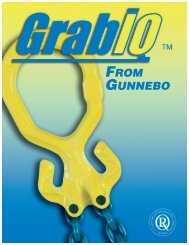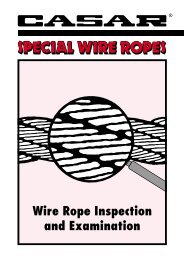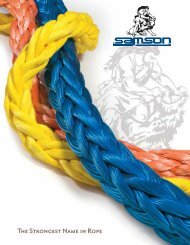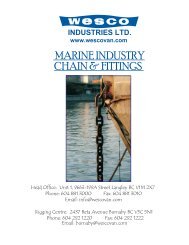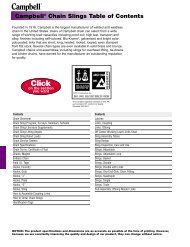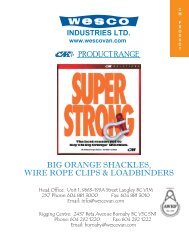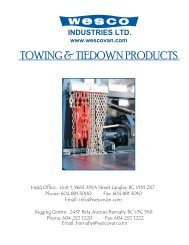Python Wire Rope - Wesco Industries Ltd.
Python Wire Rope - Wesco Industries Ltd.
Python Wire Rope - Wesco Industries Ltd.
Create successful ePaper yourself
Turn your PDF publications into a flip-book with our unique Google optimized e-Paper software.
Application Guideline<br />
Overhead Cranes<br />
Due to the vast variety of overhead cranes in service there is no<br />
'standard' rope construction which would fit all types. In most<br />
cases, cranes made in North America require imperial size ropes<br />
either, Class 6x19 or 6x36 are the traditional choices.<br />
To enhance the crane performance the use of <strong>Python</strong> ® High<br />
Performance rope is recommended. <strong>Python</strong>® wire rope can<br />
replace traditional 6-strand construction without any changes to<br />
the crane, other than making sure the sheaves and drum are in<br />
good condition.<br />
If you upgrade from a standard strength 6-strand or 6-strand diedrawn<br />
type select <strong>Python</strong>® Super 8R, in either left- or right hand<br />
lay. This type matches the breaking strength requirement but will<br />
greatly outperform any traditional rope. It requires corresponding<br />
drum grooving and thus ensures the most stable rope block you<br />
can imagine.<br />
If you experienced some block twisting you want to select<br />
<strong>Python</strong>® MULTI. Even slight block twisting is a constant<br />
inconvenience when you have to position a C-clamp into stacked<br />
coils, for example.<br />
Another application is where both rope ends are attached to the<br />
drum. The result is that 1/2 of the rope always spools into a<br />
incorrect drum grooving direction. Particularly 8-strand ropes<br />
without a plastic coated core (as provided by most OEM’s) tend<br />
to torque resulting in loose strands and waviness. Using<br />
<strong>Python</strong>® MULTI reduces and, in most cases, eliminates such<br />
problems. Because of it’s very unique construction <strong>Python</strong>-MULTI<br />
does NOT require corresponding drum grooving and still has<br />
shown the highest degree of service life increase of all <strong>Python</strong><br />
types.<br />
Some North American made overhead cranes have been<br />
converted, or can be converted, to higher lifting capacities using<br />
high strength <strong>Python</strong>® SUPER 8V, <strong>Python</strong>® HS-9V or <strong>Python</strong>®<br />
Ultra compacted constructions. We suggest not to attempt to<br />
convert your crane without professional advice, nor to select such<br />
without consultation with your local <strong>Python</strong> Distributor.<br />
Overhead Cranes and Rotation Resistant <strong>Rope</strong>s<br />
As a rule, Non-Rotating or Rotation Resistant rope types shall<br />
only be used if the lower sheave block tends to spin and <strong>Python</strong>®<br />
Multi did not cure the problem. Generally, non-rotating ropes will<br />
have a LOWER fatigue life than standard constructions, although<br />
they seem to have 'finer' wires and appear to be more flexible.<br />
Specifically 9x17 spin resistant, 19x7, 19x19, and 24x7 rotation<br />
resistant ropes tend to break up from the inside and require<br />
frequent and careful inspections. Most of these rope types on<br />
overhead cranes are smaller sizes between 5/16" and 7/16"<br />
(between 5 mm and 11 mm).<br />
For larger diameter non-rotating ropes (> 1/2” or 13 mm) we<br />
recommend <strong>Python</strong>® Lift or <strong>Python</strong>®-Hoist with a plastic<br />
coated core to prevent premature internal wire breaks.<br />
Under no circumstances do we recommend <strong>Python</strong>® Compac<br />
18 for such applications.<br />
Scrap and Grab Cranes, Piledrivers<br />
These are, in essence, "wire rope destruction machines". Some<br />
users had good results with 6x19 COMPAC® ropes, others prefer<br />
the simplicity of standard 6x19 ropes. For shock loading<br />
applications some users have had very god results with <strong>Python</strong>®<br />
Super 8V yet there were reports also of good performance with<br />
plastic (impregnated-delete) filled rope types (BXL), PFV or<br />
Cushion ropes are some trade names). In essence, we believe<br />
that the human factor, crane design, crane location, and scope of<br />
work creates such a mix of conflicting requirements that we, as<br />
the rope supplier, can only suggest that whatever works best for<br />
YOU in YOUR specific situation is also the best rope for you. This<br />
may not be the case for the chap next door.<br />
Hoisting <strong>Rope</strong> for Mobile Cranes<br />
Most of the smaller capacity US made cranes like Grove, Terex,<br />
P&H, Century, National, operate best with <strong>Python</strong>® Compac 18.<br />
It’s compacted outer rope surface is superior on multiple layer<br />
drums where traditional ropes tend to fail due to friction damages<br />
at the winding crossover points. However, <strong>Python</strong>® Compac 18,<br />
when used to it’s full fatigue life, tends to break up from the inside<br />
out (as all 19x7/19x19 rope do). Therefore, in high cycle<br />
applications and for some high load ratings (e.g. on Manitowoc's)<br />
<strong>Python</strong>®-LIFT ropes are either already installed by the crane<br />
manufacturer, or are the recommended upgrade choice. As an<br />
alternate rope selection we recommend <strong>Python</strong>® Compac 35 as<br />
this rope combines high strength, low rotation and die-drawn<br />
strands at a very attractive price.<br />
Under NO circumstances do we recommend the so called '8x19<br />
spin resistant' rope construction. In service this type of rope WILL<br />
to break up from the inside out and when used with one end free<br />
to rotate looses up to 40% of its breaking strength. Catastrophic<br />
and unexpected rope failures are the result.<br />
Hoist <strong>Rope</strong> on Tower Cranes<br />
For tower cranes we do not recommend the use of 19x7 or 19x19<br />
style rope types; this includes out <strong>Python</strong>® Compac18 . Rotation<br />
Resistant ropes (having less than 14 outer strands) are very<br />
difficult to inspect since they tend to fatigue from the inside of the<br />
rope. Also, nearly all European tower cranes require high strength<br />
non-rotating ropes and neither 19x7 nor 19x19 types fulfill the<br />
demand on strength and/or on non-rotating properties.<br />
For the older Pecco "double sheave lower suitcase block", which<br />
is used strictly in a 2-line configuration, a regular 6x36 IWRC rope<br />
is sufficient, provided the building height is no more than 10-12<br />
floors. Here, large line spacing prevents the block from spinning.<br />
For all other cranes we recommend <strong>Python</strong>® Compac 35. For<br />
extremely high strength requirements <strong>Python</strong>® Lift ropes are the<br />
choice.<br />
Linden, some Kroll- and Comedil tower cranes which have the 3-<br />
or 4 sheave arrangement in the block are 'rope killers'. The<br />
reverse bend in such systems is so severe that short rope life<br />
MUST be expected. Under NO circumstances should you use<br />
19x7/19x19 ropes. Even if you use our <strong>Python</strong>® non-rotating<br />
ropes we will NOT guarantee no bird-cages and other rope<br />
deformations as a result of such reeving systems. There have<br />
been reported sudden and unexpected rope failures. Such set<br />
ups are quick and easy to convert from a 2 part to a 4-part line<br />
but it’s not ideal from a wire rope standpoint ... and there is<br />
nothing we can do about it; you simply have to learn to live with it<br />
and INSPECT ... INSPECT ... INSPECT !<br />
-2-



